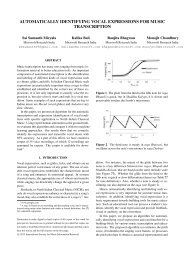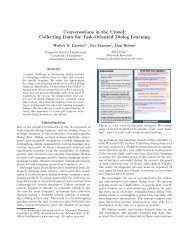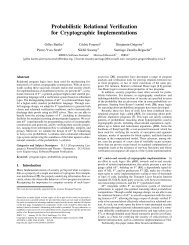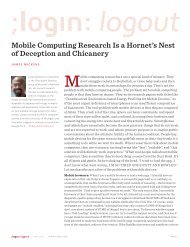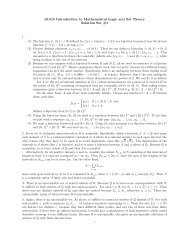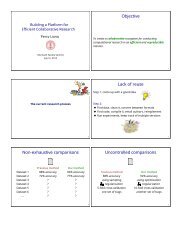On Intuitionistic Linear Logic - Microsoft Research
On Intuitionistic Linear Logic - Microsoft Research
On Intuitionistic Linear Logic - Microsoft Research
Create successful ePaper yourself
Turn your PDF publications into a flip-book with our unique Google optimized e-Paper software.
§2. Natural Deduction 37<br />
commutes to<br />
Γ1 ···<br />
A1 . . .<br />
t<br />
Γn ···<br />
An<br />
(tI)<br />
Γ1 . . . Γn<br />
(tI).<br />
t<br />
In fact, we could have been more refined for these two cases. If the minor premises were the<br />
conclusion of an elimination rule, then it would be the case that it was a subformula of an open<br />
assumption. We shall keep these more global rules as we shall see later that they correspond more<br />
closely with the steps in the cut elimination process.<br />
Now consider the Promotion rule (the introduction rule for the exponential)<br />
·<br />
!A1 . . .<br />
·<br />
!An<br />
!B<br />
[!A1 · · · !An ]<br />
·<br />
B<br />
Promotion.<br />
We have a problem here as we do not know immediately that the !Ai are subformulae of an assumption<br />
or of !B. Consider a deduction in β-normal form ending with an application of the Promotion<br />
rule. If !Ai is the conclusion of a bad elimination then a similar argument to that used earlier gives<br />
that the path need not be a subformula path. 9 For example, consider the β-normal deduction<br />
!C⊗!(C−◦A−◦B)<br />
[!C] [!(C−◦A−◦B)]<br />
[!C] Der<br />
C<br />
[!(C−◦A−◦B)] Der<br />
C−◦A−◦B (−◦E)<br />
A−◦B Prom<br />
!(A−◦B) (⊗E)<br />
!(A−◦B) !A<br />
!B<br />
[!(A−◦B)] Der<br />
A−◦B<br />
B Prom.<br />
[!A] Der<br />
Clearly the formula !(A−◦B) is not a subformula of either an open assumption nor of of the conclusion.<br />
As before we shall introduce further commuting conversions to eliminate the problematic<br />
occurrence when the conclusion of a bad elimination rule is a minor premise of an application of the<br />
Promotion rule. Thus a deduction of the form<br />
commutes to<br />
·<br />
!A1 . . .<br />
·<br />
C<br />
·<br />
C<br />
!Ai<br />
·<br />
!A1 . . .<br />
!B<br />
·<br />
!Ai<br />
(badE)<br />
!B<br />
·<br />
!Ai . . .<br />
. . .<br />
·<br />
!An<br />
·<br />
!An<br />
!B (badE).<br />
[!A1 · · ·!An ]<br />
·<br />
B<br />
Promotion<br />
[!A1 · · ·!An ]<br />
·<br />
B<br />
Promotion<br />
9 The behaviour of the Promotion rule with respect to the subformula property was omitted from an earlier<br />
paper [16].<br />
A (−◦E)



